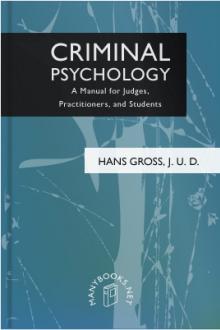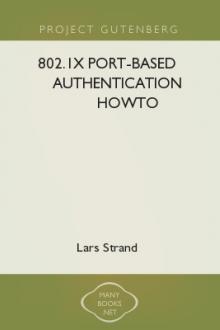Criminal Psychology by Hans Gross (classic books for 10 year olds .txt) 📖

- Author: Hans Gross
- Performer: -
Book online «Criminal Psychology by Hans Gross (classic books for 10 year olds .txt) 📖». Author Hans Gross
We have already indicated that we know only the examples cited by Z<o:>llner, Delboeuf and others. It is probable that they were hit upon by accident and that similar ones can not be discovered empirically or intentionally. Hence, it may be assumed that such illusions occur in great number and even in large dimensions. For example, it is known that Thompson discovered his familiar “optical circle illusion” (six circles arranged in a circle, another in the middle.
Each possesses bent radii which turn individually if the whole drawing is itself turned in a circle) by the accident of having seen the geometrical ornament drawn by a pupil. Whoever deals with such optical illusions may see very remarkable ones in almost every sample of ladies’ clothes, particularly percale, and also in types of carpets and furniture. And these are too complicated to be described. In the course of time another collection of such illusions will be discovered and an explanation of them will be forthcoming, and then it may be possible to determine how our knowledge of their existence can be turned to practical use.
Practical application is easier in the so-called inversion of the visual object. Fig. 7
shows the simplest case
of it—the possibility of
seeing the middle vertical
line as either deeper or
higher than the others.
In the first instance you
have before you a gutter,
{illust. caption = FIG. 7.}
{illust. caption = FIG. 8.}
in the second a room.
Similar relations are to be observed in the case of a cube in which the corner a may be seen as either convex or concave according as <p 434>
you think it behind or before the background of the angles from which a proceeds. It is still clearer when, in a rhomboid, the line XY is drawn. Then x or y
may be seen alternately as nearer
or further and the figure can
thereby be brought into a different
position. (Fig. 9.) Done once it
may be repeated voluntarily.
There are many practical examples
of these illusions. Sinsteden
saw one evening the silhouette of
a windmill against a luminous
background. The arms seemed now
{illust. caption = FIG. 9.}
to go to the right, now to the left—clearly because he did not make out the body of the mill and might equally assume that he saw it from the front or from the rear, the wheels going toward the right in the first, and toward the left in the other case. An analogous case is cited by Bernstein. If (Fig. 10) the cross made of the thin lines stand for the bars of a
weather vane and the heavy
lines represent the weather
vane itself, it may be impossible
under the conditions
of illumination for an
eye looking from N to
distinguish whether the
weather vane points NE
or SW; there is no way
of determining the starting
point of motion. All that
can certainly be said is that
the weather vane lies between
NE and SW and that
{illust. caption = FIG. 10.}
its angle is at the crossing of the two lines, but the direction in which its heads point can not be determined at even a slight distance. Both forms of this illusion may occur in a criminal trial.
If once a definite idea of some form of order has been gained, it is not abandoned or doubted, and is even sworn to. If asked, for example, whether the mill-wheel moved right or left, the observer will consider hardly one time in a hundred whether there might not have been an optical illusion. He will simply assure <p 435>
us that the thing was as he thinks he saw it, and whether he saw it correctly is purely a matter of luck.
To all these illusions may be added those which are connected with movement or are exposed by movement. During the movement of certain bodies we can distinguish their form only under definite conditions. As their movement increases they seem shorter in the direction of movement and as it decreases they seem broader than normally. An express train with many cars seems shorter when moving directly near us, and rows of marching men seem longer.
The illusion is most powerful when we look through a stationary small opening. The same thing occurs when we move quickly past bodies, for this makes them seem very short as we go by.
Of such cases sense-illusion does not constitute an adequate explanation; it must be supplemented by a consideration of certain inferences which are, in most instances, comparatively complex.[1]
We know, e. g., that objects which appear to us unexpectedly at night, particularly on dark, cloudy nights, seem inordinately magnified.
The process is here an exceedingly complex one. Suppose I see, some cloudy night, unexpectedly close to me a horse whose environment, because of the fog, appears indistinct. Now I know from experience that objects which appear from indistinct environments are as a rule considerably distant. I know, further, that considerably distant objects seem much smaller, and hence I must assume that the horse, which in spite of its imaginary distance appears to retain its natural size, is really larger than it is. The train of thought is as follows: “I see the horse indistinctly. It seems to be far away. It is, in spite of its distance, of great size.
How enormous it must be when it is close to me!” Of course these inferences are neither slow nor conscious. They occur in reflection with lightninglike swiftness and make no difference to the certainty of the instantaneous judgment. Hence it is frequently very difficult to discover the process and the mistake it contains.
[1] W. Larden: Optical Illusion. Nature LXIII, 372 (1901).
If, however, the observer finds an inexplicable hiatus in an event he happens to notice, he finds it strange because unintelligible. In this way is created that notion of strangeness which often plays so great a r<o^>le in the examination of witnesses. Hence when under otherwise uncomfortable conditions, I see a horse run without hearing the beat of his hoofs, when I see trees sway without feeling any storm; when I meet a man who, in spite of the moonlight, has no shadow, I feel them to be very strange because something is lacking <p 436>
in their logical development as events. Now, from the moment a thing becomes strange to an individual his perceptions are no longer reliable, it is doubtful whether he knows what he has really experienced before his world became strange to him. Add to this that few people are unwilling to confess that they felt ill at ease, that perhaps they do not even know it,[1] and you get the complicated substitution of sensory illusions and uncanny sensation, the one causing the other, the other magnifying the one, and so on until the whole affair is turned into something quite unrecognizable.
So we find ourselves in the presence of one of the inexplicable situations of the reality of which we are assured by the most trustworthy individuals.
[1] H. Gross: Lehrbuch f<u:>r den Ausforschungsdienst der Gendarmerie.
To magnify this phenomenon, we need only think of a few slightly abnormal cases. It has already been indicated that there are many such which are not diseased, and further, that many diseased cases occur which are not known as such, at least, as being so much so as to make the judge call in the doctor. This is the more likely because there are frequently, if I may say so, localized diseases which do not exhibit any extraordinary symptoms, at least to laymen, and hence offer no reason for calling in experts. If we set aside all real diseases which are connected with optical illusions as not concerning us, there are still left instances enough. For example, any medical textbook will tell you that morphine fiends and victims of the cocaine habit have very strong tendencies to optical illusions and are often tortured by them. If the disease is sufficiently advanced, such subjects will be recognized by the physician at a single glance. But the layman can not make this immediate diagnosis.
He will get the impression that he is dealing with a very nervous invalid, but not with one who is subject to optical illusions. So, we rarely hear from a witness that he knows such people, and certainly not that he is one himself. A very notable oculist, Himly, was the first to have made the observation that in the diseased excitability of the retina every color is a tone higher. Luminous black looks blue, blue looks violet, violet looks red, red looks yellow.
Torpor of the retina inverts the substitution.
Dietz[2] tells of color-illusions following upon insignificant indigestion; Foder<e!> of hysterics who see everything reversed, and Hoppe[3]
says, “If the order of the rods and cones of the retina is somewhat disturbed by an inflammatory touch, the equilibrium of vision is [2] <U:>ber die Quelle der Sinnest<a:>uschungen. Magazin f<u:>r Seelenkunde VIII.
[3] Erkl<a:>rung der Sinnest<a:>uschungen. Wurzburg 1888.
<p 437>
altered and changes in size, in form, or appearance occur.” Naturally the criminalist can not perceive slight indigestion, weak hysteria, or an inflamed area in the retina when he is examining witnesses, yet false observations like those described may have a definite influence upon the decision in a case.
If such abnormal occasions are lacking the reasons for optical illusions are of another nature. As a rule optical illusions occur when there is an interruption in the communication between the retina, the sense of movement, and the sense of touch, or when we are prevented from reducing the changes of the retinal image to the movement of our body or of our eyes. This reduction goes on so unconsciously that we see the idea of the object and its condition as a unit. Again, it is indubitable that the movement of the body seems quicker when we observe it with a fixed glance than when we follow it with our eyes. The difference may be so significant that it is often worth while, when much depends on determining the speed of some act in a criminal case, to ask how the thing was looked at.
Fechner has made a far-reaching examination of the old familiar fact that things on the ground appear to run when we ride by them rapidly.[1] This fact may be compared with the other, that when you look directly into swift-moving water from a low bridge, the latter seems all of a sudden to be swimming rapidly up stream, though the water does not appear to stand still. Here some unknown factor is at work and may exercise considerable influence on many other phenomena without our being able to observe the results.
To this class may be added the extraordinary phenomenon that from the train objects easily seem too near and hence appear smaller than they are. It may be, however, that the converse is true and objects appear smaller, or at least shorter, and that inasmuch as we are in the habit of attributing the diminution of size in objects to their distance, we tax the latter as false. So much is certain—that whenever we ourselves move quickly we make false judgments of size, distance, and even color. The last may be due to the fact that during a quick passage,





Comments (0)